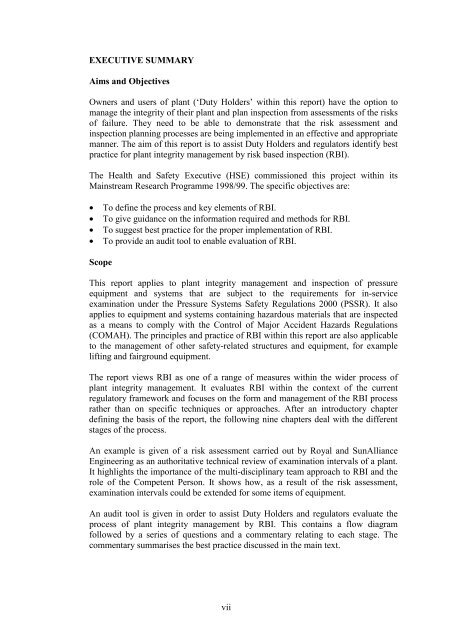Best Practice for Risk Based Inspection
risk based inspection
risk based inspection
Create successful ePaper yourself
Turn your PDF publications into a flip-book with our unique Google optimized e-Paper software.
EXECUTIVE SUMMARY<br />
Aims and Objectives<br />
Owners and users of plant (‘Duty Holders’ within this report) have the option to<br />
manage the integrity of their plant and plan inspection from assessments of the risks<br />
of failure. They need to be able to demonstrate that the risk assessment and<br />
inspection planning processes are being implemented in an effective and appropriate<br />
manner. The aim of this report is to assist Duty Holders and regulators identify best<br />
practice <strong>for</strong> plant integrity management by risk based inspection (RBI).<br />
The Health and Safety Executive (HSE) commissioned this project within its<br />
Mainstream Research Programme 1998/99. The specific objectives are:<br />
• To define the process and key elements of RBI.<br />
• To give guidance on the in<strong>for</strong>mation required and methods <strong>for</strong> RBI.<br />
• To suggest best practice <strong>for</strong> the proper implementation of RBI.<br />
• To provide an audit tool to enable evaluation of RBI.<br />
Scope<br />
This report applies to plant integrity management and inspection of pressure<br />
equipment and systems that are subject to the requirements <strong>for</strong> in-service<br />
examination under the Pressure Systems Safety Regulations 2000 (PSSR). It also<br />
applies to equipment and systems containing hazardous materials that are inspected<br />
as a means to comply with the Control of Major Accident Hazards Regulations<br />
(COMAH). The principles and practice of RBI within this report are also applicable<br />
to the management of other safety-related structures and equipment, <strong>for</strong> example<br />
lifting and fairground equipment.<br />
The report views RBI as one of a range of measures within the wider process of<br />
plant integrity management. It evaluates RBI within the context of the current<br />
regulatory framework and focuses on the <strong>for</strong>m and management of the RBI process<br />
rather than on specific techniques or approaches. After an introductory chapter<br />
defining the basis of the report, the following nine chapters deal with the different<br />
stages of the process.<br />
An example is given of a risk assessment carried out by Royal and SunAlliance<br />
Engineering as an authoritative technical review of examination intervals of a plant.<br />
It highlights the importance of the multi-disciplinary team approach to RBI and the<br />
role of the Competent Person. It shows how, as a result of the risk assessment,<br />
examination intervals could be extended <strong>for</strong> some items of equipment.<br />
An audit tool is given in order to assist Duty Holders and regulators evaluate the<br />
process of plant integrity management by RBI. This contains a flow diagram<br />
followed by a series of questions and a commentary relating to each stage. The<br />
commentary summarises the best practice discussed in the main text.<br />
vii



